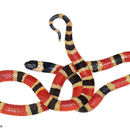en
names in breadcrumbs


Pacific side of Nicaragua, Costa Rica and Panama to adjacent Colombia. Roatán Island, Islas de Bahia, Honduras.
Holotype: USNM 7347 according to Golay et al., 1993, Endogly. Venom. Snakes World 478pp.[177].
Type-locality: Taboga Island, Bay of Panama.
Many subspecies have been described; most of these are ill-defined with a considerable amount of overlap of diagnostic characters occurring between populations. The following subspecies were recognized by Roze, 1983 [dated 1982], Mem. Inst. Butantan 46:305-338: M. n. nigrocinctus (Girard, 1854); M. n. babaspul Roze, 1967; M. n. coibensis Schmidt, 1936; M. n. divaricatus (Hallowell, 1855); M. n. melanocephalus (Hallowell, 1860); M. n. mosquitensis Schmidt, 1933; M. n. ruatanus (Günther, 1895), and M. n. zunilensis Schmidt, 1932.
M. ruatanus was recognized as a valid species by Wilson and Meyer, 1985, Snakes Honduras, 2nd ed., 159pp.[115]; Campbell and Lamar, 1989, Venom Rept. Latin Am., 425pp.[142]; and Wilson, McCranie, and Slowinski, 1992, Cat. Am. Amph. Rept. 545. 1-2[1].
There are probably several species in this complex; several populations were shown to have chromosomal differences by Gutérrez and Bolaños, 1979, Rev. Biol. Trop. 27:57-73, and Gutiérrez and Bolaños, 1981 [dated 1980], Rev. Biol. Trop. (1)29:115-122.
Micrurus nigrocinctus, commonly known as the Central American coral snake, is a species of a highly venomous snake in the family Elapidae. The species is endemic to Latin America from southern Mexico, Central America, to north Colombia.[2] There are six recognized subspecies, including the nominate subspecies described here.[3]
Common names for M. nigrocinctus include Central American coral snake, and in Spanish: serpiente-coralillo centroamericana,[3] coral centroamericana, coralillo, gargantilla, salviara, limlim, babaspul, and coral macho.[2]
The Central American coral snake is capable of growing to a total length (including tail) of 115 cm (45 in), but most are closer to 65 cm (26 in). It has smooth scales, a rounded head, and eyes with round pupils. Its color pattern can vary from two-colored to three-colored, with black, yellow and red banding.[2] The snout is black. Halfway the head, there is usually a yellow ring (in three-colored specimens) or a red ring (in bi-colored specimens). Color pattern on the body consists of often fairly broad red bands separated by much narrower sets of yellow-black-yellow bands. The numbers of black bands on the body may vary from 10 to 24, and an additional 3 to 8 on the tail.
Micrurus nigrocinctus ranges from southern Mexico through Central America (except Belize) to northwestern Colombia, and the western Caribbean.
M. nigrocinctus is mainly found in lowland rain forest, lowland dry forest, thorn forest, lower montane wet (or moist) forest, and lower montane dry forest, usually at elevations up to 1,300 m (4,300 ft).[2]
M. nigrocinctus is mainly a terrestrial snake that often dwells in burrows, leaf litter, or under logs. Like most coral snakes it is usually nocturnal, though it may also be active at dusk and dawn, and sometimes after rainfall. It feeds on other snakes, small lizards, amphibians, and invertebrates.[2] While usually not aggressive, it will bite when molested or restrained.[2]
M. nigrocinctus is oviparous.[1]
The Central American coral snake's venom contains a strong neurotoxin, causing neuromuscular dysfunction.[2] Its LD50 is 0.3 mg/kg (IV), 1.7 mg/kg (SC) and 0.4 mg/kg(IP), the venom yield is 8 mg.[4]
There are six (seven) recognized subspecies of Micrurus nigrocinctus:
Nota bene: A trinomial authority in parentheses indicates that the subspecies was originally described in a genus other than Micrurus.
Micrurus nigrocinctus, commonly known as the Central American coral snake, is a species of a highly venomous snake in the family Elapidae. The species is endemic to Latin America from southern Mexico, Central America, to north Colombia. There are six recognized subspecies, including the nominate subspecies described here.